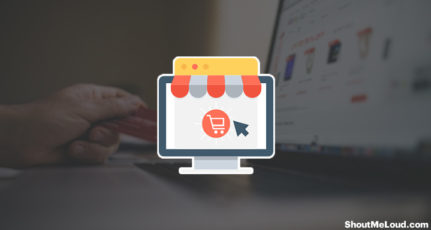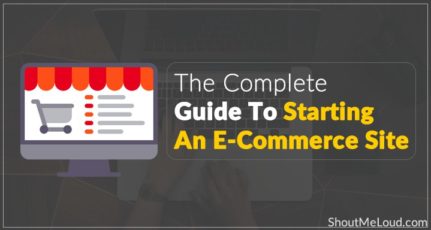
There are millions of ecommerce stores, and the number continues to rise rapidly. This is because it is a trillion-dollar industry loved by both Gen Xers and millennials. About 56% of Gen Xers and 67% of millennials prefer to shop online over in-store.

But just because there’s a lot of demand out there for ecommerce doesn’t mean it’s easy to drum up business. This is where smart promotion strategies can make a huge difference.
And in my experience, there’s no strategy more effective and affordable over the long term than content marketing. Although it isn’t easy to do well, content marketing can generate three times the leads as outbound marketing, and it costs 62% less.
Today, I am going to show you four of the top-performing tactics in content marketing for ecommerce.
Check out:
The New Age Content Marketing Tactics for E-Commerce Websites:
1. Brainstorm blog post ideas that will drive traffic and sell products
The blog posts on your ecommerce site need to achieve two goals. One is to drive qualified, sticky traffic, while the other is selling products. So, let’s start brainstorming blog posts that will work well for both of these two objectives.
First, go through your ecommerce store’s analytics. Check which of your products are selling the best. Make a note of at least the top 10 on a spreadsheet.
This step is necessary because content marketing is a long-term strategy. It can take up to six months before you see any results. If you start by writing content that promotes products that are already performing well, you will see a positive ROI sooner.
You can begin creating content for less popular items later. And if you are marketing a new store and aren’t sure which of your products will get the most sales, you can browse through the most popular products on your competitors’ ecommerce stores.
Let me show you how to do this using the biggest ecommerce store of them all, Amazon.
Visit the Amazon.com website. I am visiting the main Amazon.com website, but you should visit the site made for your target audience’s country. This is because the products and data will vary from country to country.
Next, hover over Departments in the menu. Then choose a department depending on your ecommerce store’s specialty. Let’s say for example that I have an electronics ecommerce store. So I’ll go ahead and select “Camera, Photo & Video”.

After that, click on “Bestsellers” in the menu.

This will show you the top selling products in that niche.

Check if you sell any similar products to the ones that are being sold here. If they do, look up the name of the product with your favorite keyword research tool.
One of the products that I see here is the “Smart Home Camera.” I am going to look up that keyword using Serpstat.

As you can see, in the keyword selection section, I am able to see some keyword ideas.
I like “smart home security cameras” and “best smart home camera,” because they have decent search volume.
I can use these and come up with article titles like “How to Find the Best Smart Home Camera”.
Another might be “X Tips to Find Affordable Smart Home Security Cameras”.
Repeat this process as you browse through the top products. And look up frequently used related keywords. Then, brainstorm several blog post titles that include these keywords. And add them to your content calendar.

Serpstat also has a section called “Related Keywords”, where you can see more ideas. A couple of other good keyword research tools are Ahrefs and SEMRush.
2. Optimize your content for search
Once you have a good list of blog post titles that will drive relevant traffic to your site, you can begin writing the posts.
While writing, one key rule you should follow is to keep it very long. Longer posts attract more backlinks and appear higher in search engine results.
One study found that the average word count of a Google first page result is 1,890 words. But don’t force out long content by stuffing articles up with irrelevant words. Your posts should still be full of value for your audience.

If your posts aren’t informative, people won’t read them or connect to them. So be very careful during the editing process. Hire an editor if you need to. You can also use tools like Grammarly and Hemingway to help with editing.
Also, make sure you include keywords researched from the above step in key areas of the blog post.
These areas include the first paragraph, subheadlines, last paragraph, etc. Here’s a good guide to create SEO optimised articles.

To simplify things, you can use a tool like SEMRush’s SEO Writing Assistant. It will analyze your post in Google Docs and show you if it is optimised for the selected keywords.
If your ecommerce blog runs on WordPress, you have some plugins that can simplify things. One of the better ones is Yoast.

As you can see, it provides more than keyword optimization suggestions.
It can also make it easy for you to add and edit custom meta titles and description. These are important for search engine optimization as well.
Another addition to your blog posts that can help optimize them for SEO are images, as documented by Moz.

Therefore, include as many images as possible. They can also beautify your long-form content, instead of publishing it as an endless flow of text. Your visuals can be in the form of screenshots, stock photos and even original graphics.
For taking screenshots, you can use a tool like Snagit, and you can find stock photos for free on sites like Pixabay.

After you write and optimize posts with keywords and images, you can publish them.
Then it’s time for promotion. I am not going into detail about increasing social shares, as I have covered it extensively here. You can use the same outreach strategy I mentioned there to get backlinks as well.
When you connect with influencers and ask them for shares, you just have to add a couple of lines if you decide you want to ask them to link to your content as well.
Another technique that works for gaining backlinks is summarizing blog posts into an infographic. With an infographic in hand, you can incorporate this into your backlink outreach efforts, asking influencers to syndicate the infographic along with a link back to your blog. This can get you a lot of high-authority backlinks as well.
Writing a lengthy blog post and then creating an infographic can seem like a lot of work. But it is worth the effort. I recently did this for a 5,000-word post on how to become a social media manager. Pitching out the accompanying infographic landed me a good number of inbound links pointing to my post.
3. Promote your products smartly within the content
When your content gets shared and begins ranking in search engines, you will see a surge in traffic. You should make the most of this traffic by promoting your products on your blog post pages.
Don’t make the content too salesy, or you’ll turn people off. But do make it easy for people to buy if they want to. You can do this by adding opportunities to click through from strategic spots in article pages to product pages.
An example can be seen in Hippie Butter’s post on “5 Mouth Watering Hemp Seed Recipes to Try.” Right in the middle of the blog post. you can see two ads for his products.
One is for hemp seed protein…

While the other is for Hulled hemp seeds…

There’s also a “Buy Now” button right next to the product images. To add the product to your cart, all you need to do is click on the button.
The “Buy Now” button is a feature of BigCommerce. You can add it to articles published with any blogging platform – or on landing pages, in emails or social posts. All you need to do is customize the styles, select your product and copy the code snippet. BigCommerce is also currently working on a WordPress plugin. This will allow aggregating targeted collections of products in sidebar widgets or anywhere else that supports WordPress shortcodes.
But what I like most about the buttons in this particular blog post, though, is the contextual relevance. The merchant is simply making it easy for readers who are pre-qualified to be interested in hemp seed recipes to buy hemp seed products.
Hippie Butter’s marketing team is likewise smart enough to leverage relevance when promoting products in popups. You can see them appear at the top of the screen. Here’s one of them which shows that someone purchased an “All Natural Hemp Spa Gift Set”.

You can create this using a plugin Fomo. When someone buys a product, it appears on all audience members’ pages, displaying who bought what product, from what location. When you click on the name of the product, it takes you to the landing page.
This plugin drives clicks because it works on the principle of social proof. When you see other people buying something you want, your desires are validated. And you’ll be more likely to try and get it too.
4. Convert cold traffic into leads
Even if you use the above sales tactics, most people who visit your blog won’t be interested in buying products right away. This is true for a variety of reasons.
For example, let’s look at the above post on hemp seed recipes. People might not want hemp seeds right away, because they already have them. Or they plan only to use them in the future. Or they aren’t sure if this is a trustworthy place to buy from.
Therefore, you should have a strategy in place which will help you stay in touch with them. So that you can reach out in the future when they will be ready.
The Hippie Butter blog does this in two ways. One is with the “Chat Now” option. Here people can type in any question they want and get answers.

When they do that, they become authorized contacts of Hippie Butter on Facebook Messenger, which allows the merchant to follow up with them over time.
You can set up a Facebook-powered chatbot for free with a platform called MobileMonkey, so you won’t need to dedicate too much manpower to answer the questions people leave.
The other main lead capture mechanism on Hippie Butter’s blog post pages is the “Subscribe to our newsletter” option in the footer.

Using chat and email, Hippie Butter can stay in touch with its subscribers. They can send out more free content to read, answer questions, and when the time is right, offer discounts on purchases. This helps them build trust and be remembered. And eventually, more audience members will turn from subscribers to buyers.
Drive more organic traffic and ecommerce sales with content
Get started now by following the above steps. They will help you drive more organic traffic and sales on your ecommerce store.
Start by analysing your products to see which ones sell the most. Next, begin creating content that will promote these products. You should optimize content for both Google referrals and social media shares.
After that, promote your articles to get more backlinks and shares.
To ensure that you get the most sales from these posts, you should also optimize them for sales. And don’t forget to also capture leads from cold traffic that isn’t ready to buy immediately. You can stay in touch with these leads and convert them to customers in the future.
Tell us:
How do you use content marketing to promote your ecommerce store? Which techniques have worked best for you? Please leave your comments below.
Here are a few hand-picked guides for you to read next:
- 8 Actionable Content Marketing Tips For 2020
- The Complete Guide To Starting An E-Commerce Site
- 5 Smart, Interesting Keyword Research Methods For eCommerce Stores
- From £0 to £11,000+ Per Month E-Commerce Link Building Case Study




![How To Build Your First Online Store [Comprehensive Guide]](https://www.shoutmeloud.com/wp-content/uploads/2016/10/How-To-Build-Online-Store-431x230.jpg)
Great points! It’s also so important to use content mapping. To think about where people are in the buyer’s funnel, what questions they might be asking at each stage of the funnel…and then create content that answers those questions or responds to those queries. So someone searching for “how to apply lipstick” likely isn’t looking to buy just yet…but if you create a blog post optimized for the keyword “how to apply lipstick,” then you might just be able to get those searchers to your blog and then opt in to your email updates…then you can nurture them until they make a purchase. Someone searching for “buy red lipsticks online,” on the other hand, is likely ready to buy…and will be more likely to convert. So you could create a blog post optimized for that keyword and then include call-to-actions to your product pages.
Simple brainstorming sessions do wonders for boosting blog traffic Mitt. One fave marketing tactic; thinking thru problems suffered by my readers. Folks wonder how I create so much content. All about being an observer.
Hi Ryan,
Thank you for your comment.